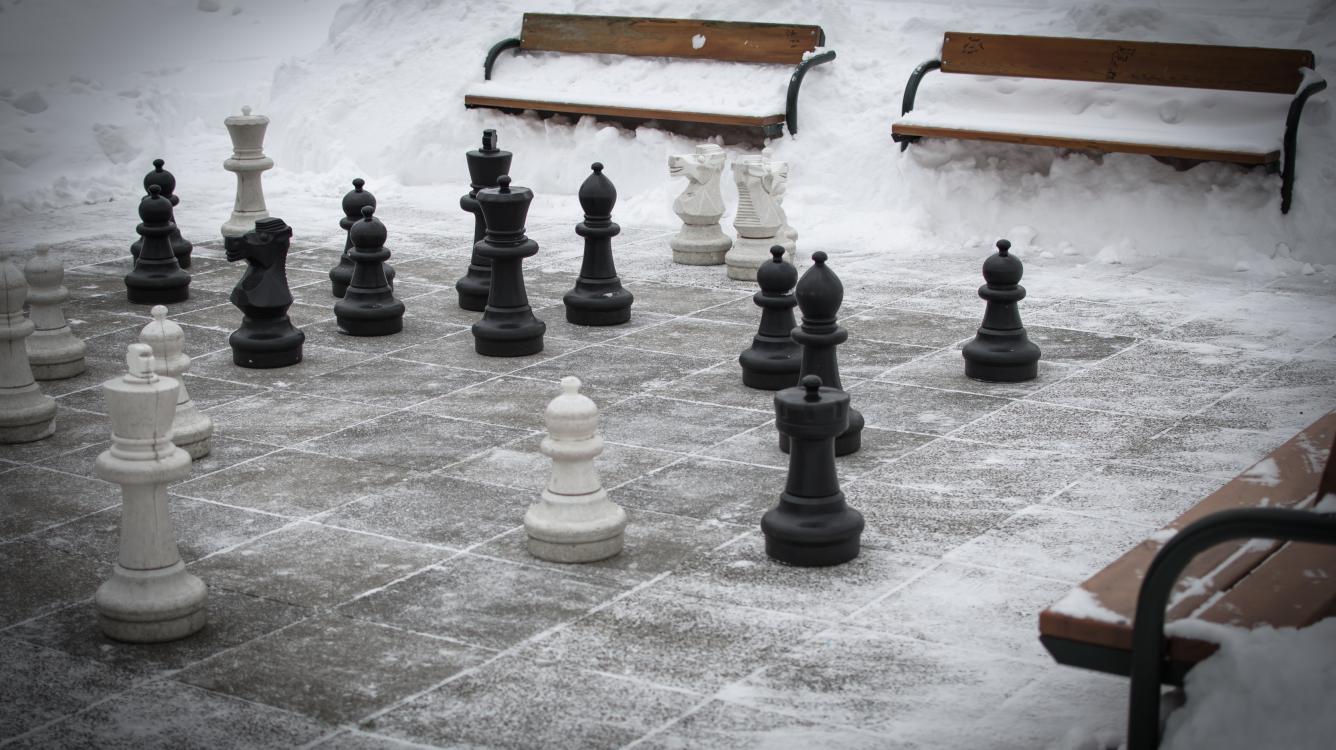
Why Is This Olympic Sport Called 'Chess On Ice'?
Curling, one of the 15 sports of the 2018 winter Olympics, is in the spotlight this week as millions of viewers worldwide tune in to watch the icy game of strategy and dexterity.
Curling has been called "chess on ice," and the comparison is a good one. There are many fun similarities between our game of chess and curling, and once you start looking for them, you see them everywhere.
So why is curling chess on ice?
Here are nine ways curling is like chess.

U.S. Olympic curler Cory Christensen. | Photo via World Curling Federation / Marissa Tiel.
9. They're both ancient games.

Curling in Toronto in 1909. Photo: Archives of Ontario via Wikipedia.
Curling began in Scotland in the early 1500s, while chess had a thousand-year head start, emerging in northern India in the sixth century.
8. They both have strategy, pieces, territory and geometry.

Curling and chess are turn-based, mathematical exercises to control territory on a two-dimensional plane: squares in chess, and the painted target (called the house) on the ice. Both are zero-sum games.
In chess, one of the most important goals is to control the center. In curling, the center is everything, as curlers throw and sweep and scream their stones to get closer to the button than the hated opposing-color rocks.

Of course, it's pretty easy to move a one-ounce chess piece across the board, or drag its virtual avatar with a mouse, but in curling you have to push a 40-pound rock 114 feet to make your move—and then you have to clean up in front of it with a broom.
7. They both have insider jargon.

The Wikipedia page "glossary of curling" lists 231 unique terms common to the game. The "glossary of chess" page has more than double that with 574 chess words.
The curling terms "cashspiel," "eight-ender," and "Manitoba truck" may sound esoteric to chess players, but are they any more inscrutable than "bughouse," "smothered mate," or "en passant"?
Plus, curling has the all-powerful hammer (the last stone thrown in an end, or inning), and chess has the undisputedly potent GM Hammer.
6. They have similar rules, tactics, offense and defense.
Curling has guards; chess has defensive pieces. With a well-thrown stone, the guards can quickly become scoring rocks, just like chess pieces can quickly swoop from defense to the attack.
In chess we have forks, where a piece or pawn attacks two or more pieces at once, and in curling there are "doubles," when a single stone takes out two opposing rocks in one throw. The maximum number of chess pieces that can be forked by a single piece is seven, while it is possible to take out up to eight opposing stones with the hammer.
Chess has "touch move," where you must move a piece you've touched, while curlers "burn stones" by accidentally touching them after they've been thrown.
Interestingly, there is no penalty in curling for accidentally playing an opponent's stone—according to expert curlers, it "happens all the time." In chess, if you move your opponent's piece, you're definitely in line for some sort of penalty, depending on the tournament rules.
5. They both have fun exclamations.
Players may call out "check!" in casual chess games when placing the opposing king under attack. This practice fades away as the games become more serious, but it's an important part of learning to play.
In curling, the exclamation is "sweep!" as curlers implore their teammates to mop the ice in front of a stone, reducing friction and lengthening a throw. This is true from the most casual curling club to the Olympic gold-medal game.
And it's not just in English. From my extensive research, I have determined that the Russian word for "sweep!" is, in fact, "sveep!"
The Russian word for "check" is apparently "Шах," which looks like the word "wax" to me even though it's probably not pronounced that way.
4. They both use new technology to improve an old game.
While chess has DGT boards, online streaming, and self-taught artificial intelligence that could lead to a revolution in machine learning, curling stones are now equipped with a hand sensor that turns on a red light if the stone is released illegally past the all-important "hog line."


Image source: Eye On the Hog (advanced curling technology company).
So both games are extremely high-tech.
3. They both sometimes have injuries.

Photo: Getty Images via dailymail.co.uk.
Curling and chess may not have the daredevil reputations of the more extreme sports, but make no mistake, you can hurt yourself in these cerebral games.
This week, the Russian curler Anastasia Bryzgalova took a tumble after tripping over an unseen stone. (She was O.K.)

Photo: Mike Klein/Chess.com.
Last fall in St. Louis, the young American chess star Wesley So hit a chess clock so hard he left a bloody residue. The clock was cleaned with a Lysol wipe and placed back into duty the next round.
2. You can resign in both.

In most sports, it would be a major scandal to give up midway through a game (unless you're the 76ers).
In curling, as in chess, it is considered good form to resign with a handshake once it is impossible to win.
It is traditional for the winners in curling to buy the losers a drink, while in chess it is still unknown which player is supposed to pay for post-game cocktails.
1. I still don't understand either game.

After playing chess for decades, and watching curling for literally hours, I know I've got a lot to learn about both games.
Do you think curling is chess on ice? Let us know your thoughts in the comments.






